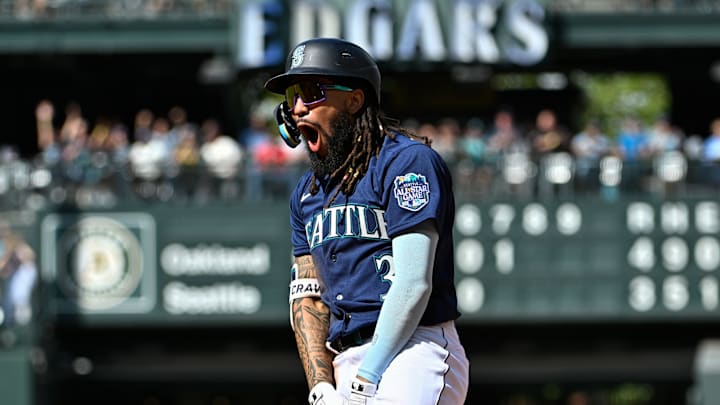J.P. Crawford has been a full-time major-leaguer since 2019 but other than a Gold Glove win in a COVID-shortened 2020 season, he's been pretty quiet. Throughout his career, he's typically hit around or below league-average but this year, he's slashing an incredible .268/.385/.421 for a total OPS of .806 and an OPS+ of 127. So what changed?
Exit Velocity and Quality Contact Upgrades
The two stats that stand out the most are his average exit velocity and HardHit%. Crawford was in the bottom 3% of the league in terms of average exit velocity last year, averaging 85.1 mph off the bat. This year, he's averaging 88.8 mph, a big difference. In fact, he's closer to Julio Rodriguez's average exit velocity (92.0 mph) than he is to 2022 J.P. Crawford's.
This is further helped by the fact that he's making quality contact more frequently than ever before. His HardHit% of 37.1% is still below league-average but a big improvement over last year's mark of 29.7%. He's topping balls ~10% less frequently and getting enough lift to bring his launch angle to a more beneficial 14.3 degrees.
And it's paying dividends. When's the last time you saw Crawford hit a ball this far into the right center field seats at T-Mobile park?
One pitch is all it takes.
— MLB (@MLB) August 26, 2023
J.P. Crawford didn't wait around to get the @Mariners on the board. pic.twitter.com/HGzx8zGhFZ
These results can likely be attributed to his offseason work at at Driveline Baseball in Kent, WA. After discussing his displeasure with the results of last year's ALDS, Crawford was determined to better utilize his strengths at the plate and realize his full hitting potential. At Driveline, he was able to make key adjustments to his swing and got great insight from the data-driven facility that also helped the likes of Lars Nootbaar and Nolan Arenado.
What Were The Tradeoffs?
Like our parents say all too often, there's no such thing as a free lunch, so what did Crawford give up to get more power in his bat? The answer is not much.
The main statistic that has regressed since last season is his strikeout rate where he's getting punched out at a 19.2% (68th percentile) vs. last year's number of 13.3% (93rd percentile). However, he's been able to compensate for this by increasing his batting average from .243 to .268 while also increasing his walk rate from 11.3% (86th percentile) to 15.5% (97th percentile).
He's also gotten worse at hitting the slider, posting a somewhat dismal .145 BA and 30.8% strikeout rate against the pitch, but he's improved his ability to hit four-seam fastballs significantly, generating 18 more run value against that pitch over last season.
His batting run value increased from -5 in 2022 to 17 in 2023 and he currently has the second-highest rWAR on the team (4.1), behind just Julio Rodriguez. Sure, he still lacks the defensive abilities of names like Dansby Swanson and Francisco Lindor, but he's undoubtedly shown just how valuable he can be to this team.
Future Outlook
The race for the AL West title remains tight with the Houston Astros and Texas Rangers putting up quite the fight. For this last month of the season, the team will need all hands on deck, especially given the strength of the remaining schedule. Moreover, if the Mariners want to make a deeper playoff push, J.P. Crawford will be an integral part of getting them there. With his new swing upgrades, he just might pull it off.
